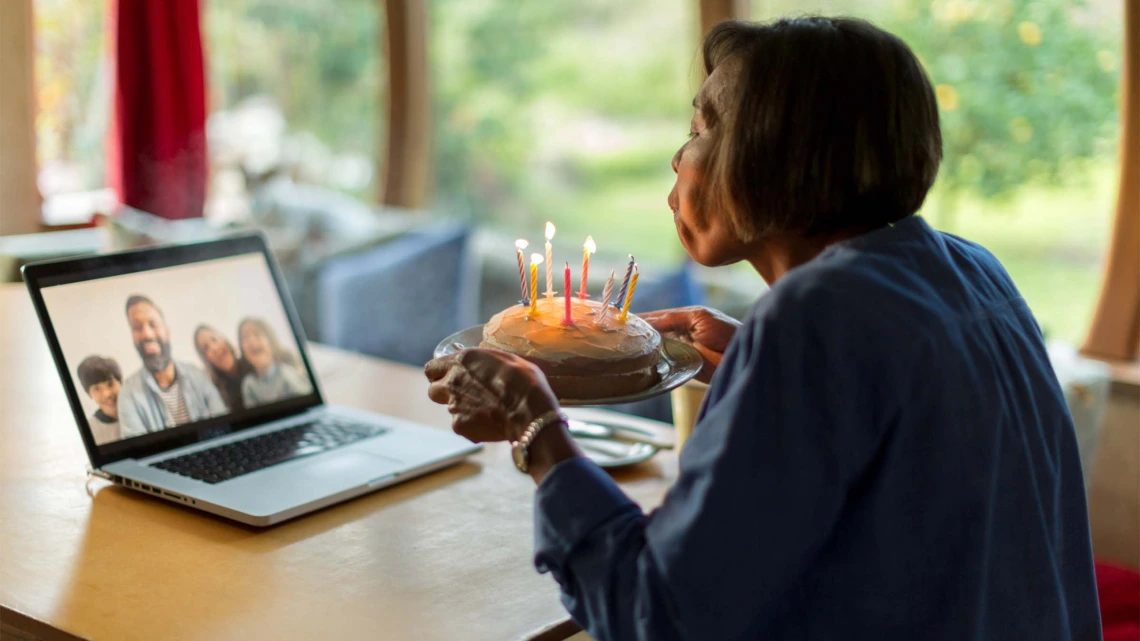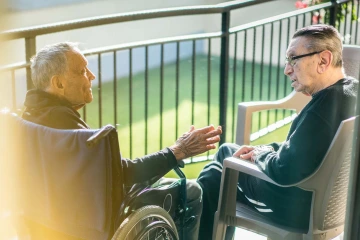Connection Vital for Older Adults During the Pandemic
Health Sciences experts say resilience helped many older adults overcome the “second pandemic” of social isolation.

Family and friends used technology to connect with older adults during the pandemic.
While the COVID-19 pandemic has affected all age groups, older adults have borne the brunt of the crisis in terms of hospitalization and mortality. University of Arizona Health Sciences experts say COVID-19 hasn’t been the only pandemic affecting older people.
“We knew about the increased risk for older adults based on preexisting health conditions, but we didn’t pay much attention to the preexisting social conditions of loneliness and isolation, which was already a pandemic among the older adult population,” said Amanda Sokan, PhD, MHA, LLB, assistant professor in the department of public health practice and translational research at the Mel and Enid Zuckerman College of Public Health.

Amanda Sokan, PhD, MHA, LLB
Dr. Sokan says physical distancing and stay-at-home policies had negative impacts on older adults who rely on a larger social network, even as those practices protected them from transmission.
“The CDC guidelines had unintended consequences, especially for a population who depends on other people for care, support, and necessities like food and medication,” Dr. Sokan said. “That’s not to say we should not have done the social distancing, that’s just to say we should have thought about the downstream implications for this population and positioned ourselves to address that.”
The current pandemic has much to teach us when it comes to issues like access to technology and the importance of social connection and resilience, according to Health Sciences experts. By learning what worked and what didn’t, we can design better strategies for protecting older people’s health and mental well-being in future pandemics.
The benefits and barriers of technology
During the pandemic, many older adults bridged the social gap with technology, which could range from relatively low-tech tools like the telephone to the video-chat features offered by smartphones and webcams.

Kathleen Insel, PhD, RN
But technology also brings challenges for older adults.
“Sometimes they can’t see the screen on a smartphone. It’s just too small, even the bigger screens,” said Kathleen Insel, PhD, RN, professor and chair of the Biobehavioral Health Science Division in the College of Nursing.
There is also wide variation in computer literacy among older people, who are generally divided into the “young old,” who are 65 to 74 years old; the “middle old,” between 75 and 84; and the “oldest old,” who are 85 and older.
“There are definitely generational differences,” Dr. Insel said. “The young old are savvier, while the oldest old may have trouble navigating a screen with a mouse.”
Access also is an issue, as 36% of older adults do not have a broadband connection at home and 39% do not have a smartphone. Without those technologies, people can’t use video chat for telehealth appointments or to socialize with friends and loved ones.

Lorraine Martin-Plank, PhD, FNP-BC, NP-C, GNP-BC
“A lot of older adults have flip phones,” said Lorraine Martin-Plank, PhD, FNP-BC, NP-C, GNP-BC, clinical professor in the College of Nursing, adding that some medical conditions could preclude the use of video chat platforms. “It’s difficult at best for people with dementia to recognize their family members when they visit. Trying to do it on a video conference is really impossible.”
Applying resilience
Though it’s too early to fully characterize the pandemic’s impact on older people, the research so far, summarized in an article published in the Journal of the American Medical Association, shows that older adults have been less affected by anxiety, depression and stress-related mental health disorders compared with younger generations, and had lower rates of substance abuse and suicidal ideation.
“It wasn’t all doom and gloom,” Dr. Sokan said. “We learned that older adults are a very resilient group in terms of their attitudes and how they coped with the pandemic and the restrictions to their social interactions.”
The JAMA article cites studies showing that older people tend to have more wisdom and compassion, which may be protective against loneliness. Older people may also have better control over their emotions and an increased capacity to respond to stress.
“There’s wisdom among older adults. There’s perspective and understanding of what’s important, what isn’t,” Dr. Insel said. “Some of these strategies have helped them survive.”

Social connection and compassion allow people to build resilience as they age.
Dr. Martin-Plank shared the story of her husband’s uncle, who took care of his parents until they died. At that point, he expanded his community involvement, connecting with a local nursing home to take patients to medical appointments and on other errands.
“When he became disabled, the nursing home told us, ‘He did so much for us. We’re going to take care of him.’ They took him as a charity case, but he was treated with great respect,” Dr. Martin-Plank recalled. “When we would visit him, we could never find him. He was out visiting this one and that one. He adapted amazingly to being in a nursing home.”
Developing a deeper understanding of resilience and other traits that gave some older people better coping skills during the pandemic can equip researchers for future pandemics.
“The lessons we’re learning should be fed back to science so we can be better prepared for what’s to come in the future,” Dr. Sokan said. “We can harness the good practices that came out during this pandemic, improve on them, and be better prepared the next time this comes around.”
“There are ways we can address these things,” Dr. Insel added. “That gives me hope.”

